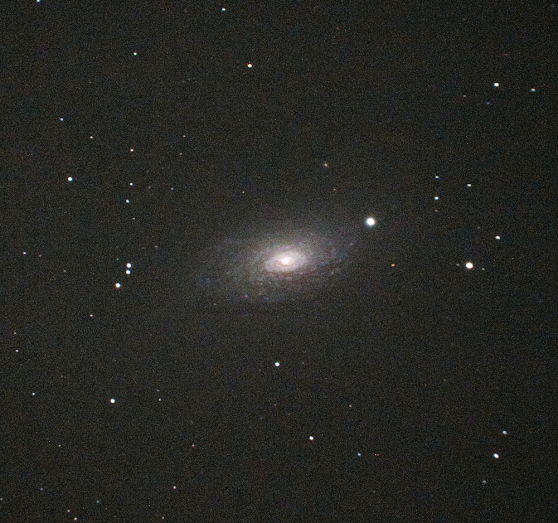Monday, April 25, 2022
Galaxy M 100
Friday, April 22, 2022
Four (or Five) Planets in a Row Early in the Morning!
Were you up before sunrise today and saw FOUR planets in a row?
I wasn't but a fellow member of the Huachuca Astronomy Club was and this is her (Karen Madtes) shot!
Left to right: Jupiter, Venus, Mars and Saturn
(Bonus but too dim to be in this shot... Neptune, which is between Jupiter and Venus from our perspective!)
P.S. They will be visible for a few more weeks so get out there and enjoy the view, just be sure you have a relatively good view of the south-eastern horizon about 4:30 am !
Thanks, Karen!
Thursday, April 21, 2022
The Blackeye Galaxy, M 64
I Spy a Supernova!
Sometimes in galaxy season one can catch a supernova in a galaxy far, far away! Here is a new supernova between M60 (the larger galaxy/fuzzball) and the galaxy NGC 4647 (the smaller fuzzball) and the supernova is the star between the two galaxies but closer to the smaller galaxy.
Details: Captured with a Celestron 6 inch f/10 SCT on a AVX mount with a Canon t3i DSLR body with a L-Pro filter. This is the resulting stack of 10 images using Affinity Photo, each image was 7 minutes long at iso 6400 for a total of 70 minutes of exposure. Cropped to 1/4 of the original frame size.
Supernova data sheet: https://www.rochesterastronomy.org/supernova.html#2022hrs
Monday, April 4, 2022
M 51 (try again!)
Sunday, April 3, 2022
The "Owl" Nebula (Messier 97 aka NGC 3587)
The "Owl" Nebula (M 97, NGC 3587) is a small nebula near the bottom of the "Big Dipper's cup". It is a starburst ("planetary") nebula approximately 2,030 light years away. Although the Owl Nebula can not be seen with the naked eye, a faint image of it can be observed under remarkably good conditions with a small telescope or 20×80 binoculars. To make out the nebula's more distinctive owl like eye features, a telescope with an aperture 10" or better is required.
But with long photographic exposure (in this case 15 images of 4 minutes each, then stacked for a total of one hour of exposure and then post-processed) I was able to capture it for your enjoyment! I have posted two images of it because its true color is difficult to determine (just google it and you will see that some make it blueish and others more green).
Which do you like?
Saturday, April 2, 2022
The Sunflower Galaxy - M 63 - Two Hours of Integration vs One shot
This beautiful galaxy is known as Messier 63 or M63, also known as NGC 5055 or sometimes called the Sunflower Galaxy. It is a spiral galaxy in the northern constellation of Canes Venatici (south of the handle of the Big Dipper's handle) with approximately 400 billion stars!
I imaged it last night (April 1st, no foolin' !) taking 30 - 4 minute exposures for a total time of 2 hours of integration. I used a Meade LX200GPS 8" telescope with a .65 focal reducer, an ultra high contrast filter and a modded Canon T3i camera.
Notice the dark dust lanes the block a lot of the light from the lower part of the galaxy. The pink areas are regions of star formation.
So what does it look like when one only takes ONE image, instead of stacking 2 hours worth of 4 minute exposures?
M51 with new astro camera!
Messier 51 aka the Whirlpool Galaxy (Click for a little larger image) Taken April 24, 2025 from my observatory with the Daystar 480mm f/6 ...

-
The Copernicus region of the Moon has many interesting features. What unusual or unexpected features do you see? Image taken February 6, 202...
-
The above is the result of 3 hours of imaging on January 24, 2025 of "Thor's Helmet" nebula (aka NGC 2359) with the ZW0 585M...
-
This is actually a LARGE image so to explore the Moon: First click on this photo to open it in another tab... (it might take a few moments f...












